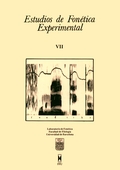La invariación acústica en el punto de articulación de las oclusivas del español
Abstract
The aim of this study is to check whether the short-time spectra sampled at the onset of Spanish stops, present invariant acoustic properties that specify consonantal place of articulation. S.E. Blumstein and K.N. Stevens (1979) hypothesized that the spectra match three classes of spectral shapes or templates: diffuse-rising, diffuse-falling and compact, corresponding to alveolar -dental in Spanish-, labial and velar consonants, respectively. In our study we have followed sistematically, the experimental procedures designed by Blumstein and Stevens to test whether this hypothesis could also be proved in Spanish. However, our results were not as encouraging as theirs: only 48% of the labial consonants matched against the diffuse-falling shape -using a 26 ms time window-.When we used a 10 ms window, only 31,5% matched the template. Dental consonants were better classified when we used the shorter-time window. Velar consonants were a case apart: 100% of the spectra were correctly classified by the templates. Therefore, the overall results obtained for Spanish do not support Blumstein and Stevens's hypothesis, since neither labials, nor dentals were consistently classified by their corresponding templates.
Downloads
Published
How to Cite
Issue
Section
License

This work is licensed under a Creative Commons Attribution-NonCommercial-NoDerivatives 4.0 International License.
All articles published online by Estudios de Fonética Experimental are licensed under Creative Commons Attribution-NonCommercial-NoDerivs 4.0 International (CC BY-NC-ND 4.0 DEED), unless otherwise noted. Estudios de Fonética Experimental is an open access journal. Estudios de Fonética Experimental is hosted by RCUB (Revistes Científiques de la Universitat de Barcelona), powered by Open Journal Systems (OJS) software. The copyright is not transferred to the journal: authors hold the copyright and publishing rights without restrictions. The author is free to use and distribute pre and post-prints versions of his/her article. However, preprint versions are regarded as a work-in-progress version used as internal communication with the authors, and we prefer to share postprint versions.




